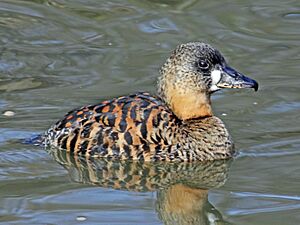White-backed duck facts for kids
Quick facts for kids White-backed duck |
|
|---|---|
 |
|
| Conservation status | |
| Scientific classification | |
| Genus: |
Thalassornis
|
| Species: |
leuconotus
|
| Subspecies | |
|
|
The white-backed duck (Thalassornis leuconotus) is a special kind of waterbird found in Africa. It belongs to the Anatidae family, which includes all ducks, geese, and swans. This duck is quite unique compared to other ducks. It is the only member of its group, called Thalassornis.
Contents
About the White-backed Duck
These birds are amazing divers. They can stay underwater for up to half a minute. They often search for the bulbs of waterlilies to eat. They also enjoy seeds and leaves from water plants. Young ducks eat tiny lake flies larvae.
When these ducks feel danger, they dive underwater to escape. This is why their white back, which gives them their name, is hard to see in the wild.
Where White-backed Ducks Live
White-backed ducks live in Africa. You can find them from Senegal and Chad in the west, to Ethiopia in the east, and all the way down to South Africa in the south.
Their Homes
These ducks like to live in places with water. Their homes include lakes, ponds, swamps, and marshes. In these watery areas, their colors help them blend in. This keeps them safe from animals that might try to hunt them.
Different Kinds of White-backed Ducks
There are two main types, or subspecies, of white-backed ducks. They are called Thalassornis leuconotus leuconotus and Thalassornis leuconotus insularis.
Madagascar's Special Duck
The Thalassornis leuconotus insularis subspecies lives only on the island of Madagascar. This group of ducks is considered to be in danger. They face threats like hunting and losing their homes. Also, new animal species brought to Madagascar compete with them for food and space.
Protecting White-backed Ducks
The white-backed duck is part of an important agreement. This agreement is called the Agreement on the Conservation of African-Eurasian Migratory Waterbirds (AEWA). It helps protect waterbirds that travel long distances.
In 2001, experts studied the Madagascar ducks at Lake Antsamaka. They found 37 nests, showing how important this one lake is for these ducks. Some experts think there might be around 2,500 to 5,000 white-backed ducks in Madagascar. In Africa, there might be between 10,000 and 25,000 of these birds. Protecting their homes is very important for their future.
Images for kids







